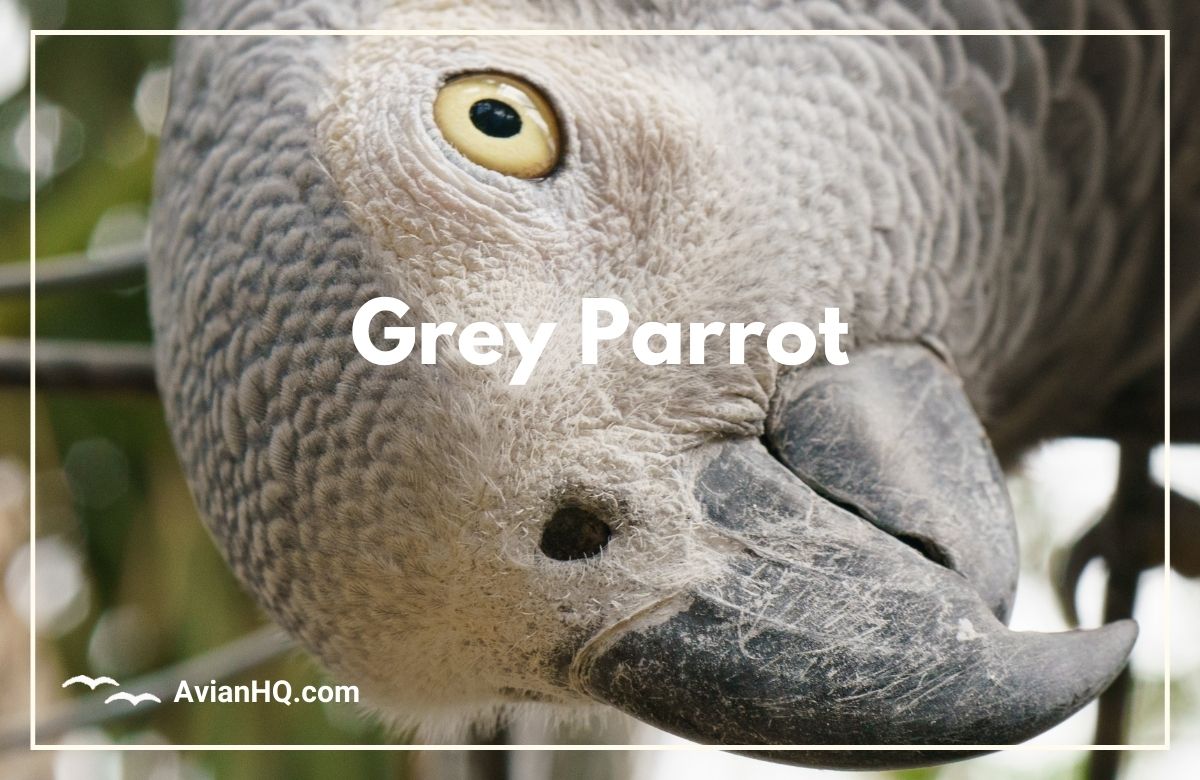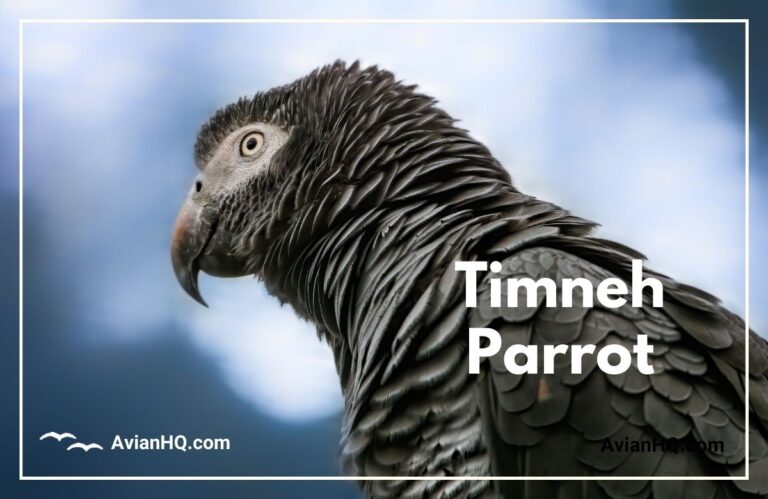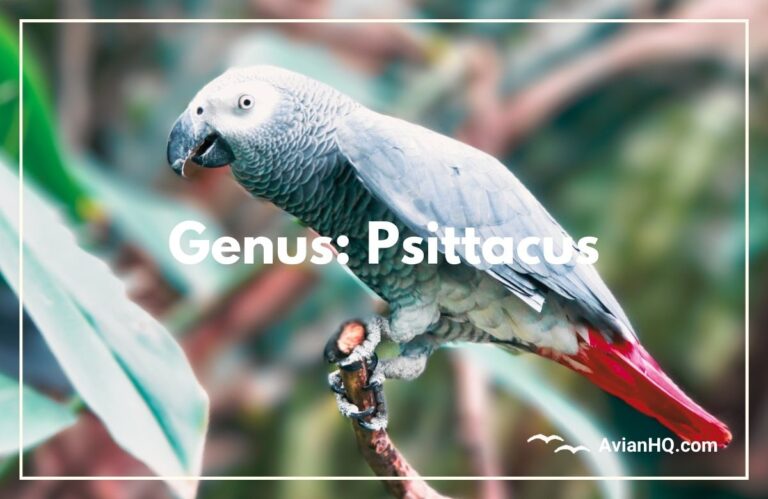Grey Parrot (Psittacus erithacus)
With it’s stunning scales of gray feathers accented by bright red tail feathers, the Grey Parrot (Psittacus erithacus) is one of the most recognizable parrots in the world. When you first glimpse these birds in flight or perched high in rainforest canopies, you’ll surely be captivated by their beauty. But beyond it’s physical appearance, the Grey Parrot has another claim to fame—its astonishing intelligence.
“The African grey parrot is one of the most talented talking/mimicking birds on the planet.”
In recent decades, groundbreaking research has revealed that Grey Parrots have cognitive abilities on par with great apes and human toddlers. They can learn vocabulary of over 1,000 words, use language appropriately in context, add quantities, and recognize shapes, colors, and materials. This combination of advanced intelligence and the ability to mimic human speech has made the Grey Parrot a highly coveted pet bird. However, excessive trapping of Greys for the pet trade has raised serious conservation concerns. Both subspecies of Grey Parrot are now classified as Vulnerable on the IUCN Red List.
When reading up on these fascinating birds in the wild and in homes, you’ll encounter some key facts:
- Grey Parrots are medium-sized birds measuring 13-16 inches (33-40 cm) long and weighing 14-22 ounces (400-650 grams).
- They originate from the tropical forests of Central and West Africa.
- Two subspecies exist—the Congo African Grey and the Timneh African Grey.
- Their natural diet consists of fruit, seeds, nuts, and some vegetation.
- Grey Parrots are highly social and intelligent, living in flocks of up to 1,000 birds.
- They can live over 50 years with proper care in captivity.
This article will provide an in-depth look at Grey Parrot biology, behavior, intelligence, conservation status, and cultural significance across Africa and the world. Read on to learn more about one of nature’s most astonishing avian species.
History and Taxonomy of the Grey Parrot
The first known written account of the Grey Parrot comes from 1402 when Portuguese traders occupied the Canary Islands and encountered Grey Parrots that had been introduced there. As Portugal increased it’s trade relationships along the west coast of Africa over the following centuries, more Greys were captured and transported back to Europe to be kept as pets. These exotic parrots soon caught the attention of scholars and artists across the continent.
It wasn’t until 1758 that the species received it’s scientific name Psittacus erithacus from the legendary taxonomist Carl Linnaeus in the 10th edition of his work Systema Naturae. The genus name Psittacus is the Latin word for “parrot”, while the species name erithacus comes from the Ancient Greek term erithakos meaning “a bird that mimics human speech.”
For over two centuries, the Grey Parrot was considered a single species with no recognized subspecies. But in 2000, avian taxonomists identified two distinct subspecies based on physical, genetic, and behavioral differences:
- Congo African Grey Parrot: Psittacus erithacus erithacus, the nominate subspecies commonly known as the Congo Grey Parrot or Red-tailed African Grey Parrot. This is the larger of the two subspecies, measuring 13-16 inches (33-40 cm) long and weighing 14-22 ounces (400-650 grams). It has silver-gray feathers, darker on the head and wings, along with bright red tail feathers. It’s natural range extends from Côte d’Ivoire to Uganda and Kenya.
- Timneh African Grey Parrot: Psittacus erithacus timneh, or the Timneh Grey Parrot. This smaller subspecies measures 9-11 inches (23-28 cm) long and weighs 8-13 ounces (250-375 grams). It has darker charcoal grey plumage, a darker maroon tail, and a horn-colored upper beak mandible. It’s native habitat spans from Guinea-Bissau to Sierra Leone and western Côte d’Ivoire.
This division into two subspecies is now widely accepted by ornithological authorities. Beyond the visual differences, Congo Greys and Timneh Greys have distinguishing bone structures and behaviors that set them apart. Their territorial ranges also do not overlap in the wild. Nonetheless, both subspecies make for excellent companion parrots when raised in captivity.
Physical Attributes of the Stunning Grey Parrot
The Grey Parrot is a medium-sized parrot yet one of the largest of the African parrot species. As noted previously when discussing taxonomy, two distinct subspecies exist with the following physical differences:
Congo African Grey Parrot
- Size: Measures 13-16 inches (33-40 cm) long with a wingspan of 18-20 inches (46-52 cm). Weighs 14-22 ounces (400-650 grams).
- Plumage: Predominantly pale gray feathers with slightly darker gray on the head, wings, and thighs. Feathers have fine white edges giving a scalloped effect.
- Tail: Bright red tail feathers. Some mature birds may get red feathers scattered amid gray body plumage.
- Bill: Black-colored beak.
- Eyes: Dark brown as juveniles then fade to yellowish silver with maturity.
- Legs: Sturdy gray legs with zygodactyl feet typical of parrots.
Timneh African Grey Parrot
- Size: Smaller subspecies, measuring 9-11 inches (23-28 cm) long with a wingspan around 15 inches (38 cm). Weighs 8-13 ounces (250-375 grams).
- Plumage: Dark charcoal grey feathers covering most of body, wings, and tail.
- Tail: Deep maroon coloring on short tail feathers.
- Bill: Two-toned mandible with shell pink at base fading to black at tip.
- Eyes: Yellow-tinged irises from young age.
- Legs: Same zygodactyl feet adaptation as Congo relative.
The eyes of young chicks start out black in both subspecies, but transition to a light silver or yellow within their first year. Identifying isolated Greys in the exotic pet trade can be tricky, but their body proportions, beak color, and vocalizations provide clues on which subspecies they belong to. Both the Congo and Timneh parrots demonstrate slight sexual dimorphism as well with males typically being marginally larger.
Native Habitat and Range of Grey Parrots
Grey Parrots reside in the tropical regions of Central and West Africa straddling the equator. The Congo African Grey inhabits a wide swath of rainforest habitat from Côte d’Ivoire eastwards to Uganda and Kenya. It’s extent stretches from offshore islands in the Atlantic to areas inland at altitudes up to 5,900 feet (1,800 meters).
The smaller Timneh African Grey has a more restricted range along the western edge of the Ivory Coast through Guinea, Sierra Leone, and Liberia. Both subspecies favor lowland forests but also inhabit wooded savannas, gallery forests, mangrove stands, and agricultural areas. They are quite adaptable as long as old-growth trees are available for roosting and nesting.
Outside of Africa, small introduced populations of escaped pets exist in areas like Puerto Rico and southern Florida. But there is no evidence these transplanted grey parrots are sustaining wild breeding populations. For true African Greys thriving in their native habitat, ecotourists must venture across the Atlantic and trek into remote rainforest pockets where flocks still gather.
Unfortunately even the core areas of the Grey Parrot’s homeland are under increasing threat from logging, agricultural expansion, and trapping for the pet trade. Their specialized habitat needs and low reproductive rates make wildlife experts fear both subspecies may disappear from the wild without increased preservation efforts. For now, vibrant Congo and Timneh populations are confined to African nature reserves offering protected old-growth forests that these beloved birds depend on.
Diet and Feeding Habits in the Wild
In their native habitat, Grey Parrots are generalist feeders consuming a varied diet from multiple plant food sources. Their main natural diet consists of:
- Fruits – Figs, plums, berries, palms, banana, and other soft fruits.
- Seeds – Hard nuts and seeds of various rainforest trees and vegetation.
- Vegetable Matter – Flowers, buds, shoots, bark, and stems of select plants.
The most critical food resource for many Grey Parrot populations is the oil palm fruit. These vivid red oval fruits grow in dense clusters weighing over 6 pounds (3 kg) each. Grey Parrots use their strong beaks to crack open the pulp and access the seed inside.
Flocks engage in daily travel between communal roosting sites and key feeding areas across their home range. They may fly over 15 miles (25 km) to target specific fruiting trees. Most foraging occurs in the high canopy layers using their zygodactyl feet to grasp branches. But Grey Parrots also descend to lower levels and ground to ingest clay, minerals, and snails or insects on occasion.
In the wild, Greys spend nearly 80% of daylight hours actively foraging and feeding. Only hummingbirds rival parrots for the amount of time budgeted to finding food. Abundant food sources allow Grey Parrots living in African reserves or zoos to breed year round. But wild pairs tend to nest in alignment with peak dry seasons when fruit production is highest across their habitat. This ensures plenty of nutrition for rearing demanding chicks.
Breeding Behaviors and Reproductive Habits
Grey Parrots are monogamous birds that mate for life. They reach sexual maturity between ages 3-5 years. Due to delayed breeding maturity and small clutch sizes, they have a very low reproductive rate compared to other parrots.
Wild pairs nest in tree cavities, with each pair requiring it’s own dedicated nesting tree within it’s defended territory. Nest height ranges widely based on tree size and availability, but averages around 100 feet (30 meters) high. The female typically lays 3-4 eggs (max 5) which she then incubates for 30 days while being fed by her mate.
After hatching, both parents devote themselves fully to raising and protecting the chicks. They brood hatchlings to keep them warm and convey food from up to 18 miles (30 km) away. Nestlings fledge at 10-12 weeks old but continue roosting in the nest while learning to feed themselves over the next month. Fledglings then remain closely associated with their parents during a extended maturation phase of 2-3 years.
In the wild, the slow-paced breeding strategy of Grey Parrots allows them to successfully raise only a few chicks each year. This compares to smaller parrots that can produce several broods of 5-10 offspring annually. But the payoff is longer-lived Greys spending decades passing on foraging knowledge and dialects to younger cohorts. Disrupting these delicate age hierarchies and cultural transmission networks can profoundly impact Grey Parrot conservation over time.
Captive breeding programs for the pet industry have accelerated Grey Parrot reproduction through optimized nutrition and nest boxes. However this has tipped gender ratios and truncated the rich behavioral education wild juveniles require. Ensuring Grey Parrot survival increasingly depends on balancing captive propagation goals with safeguarding natural social structures.
Complex Behaviors and Social Ecology
One of the key characteristics setting Grey Parrots apart from other birds is their complex social behavior and group dynamics. They are highly social creatures that innately orient towards living in large communes. Wild Greys gather in flocks of 10-30 birds on average, but spectacular roosting assemblages can exceed 1,000 individuals!
These boisterous flocks roam the canopy by day foraging for food before retreating to a traditional night roost site. At the roost, Grey Parrots jostle closely together on an emergent tree that offers views to spot predators. And being prey for powerful raptors certainly keeps them dependent on the safety of numbers.
But living in cooperative groups confers many other advantages too. Juveniles stay immersed in the flock over years steadily acquiring new skills essential to survival. Vocal communication bolsters social bonds while coordinating movement between key resource zones across their home range. If separated, Grey Parrots even have distinct contact calls used to locate fellow flock members.
Some researchers compare the information conveyance seen in wild Grey Parrot flocks to the dynamics of a similarly structured primate troop. The fact that Grey Parrots can also learn the vocal signals of other forest species points to an adaptive cognition attuned to the complex language of the tropical ecosystem it’self.
Unraveling the secrets embedded in the cultural knowledge and communal relationships of Grey Parrots poses an ongoing scientific challenge. But ecosystems clearly suffer when these dynamics are disrupted by excessive losses of mature birds from the wild. Their disappearance breaks vital conduits for passing learned forest wisdom down through generations.
Alarming Decline and Protection Efforts
Both the Congo African Grey Parrot and Timneh African Grey Parrot are classified as Vulnerable on the IUCN Red List of Threatened Species. This means they face a high risk of extinction in the wild in the medium-term future.
The major factor threatening Grey Parrot populations is trapping for the international live pet bird trade. From 1982-2001, an estimated 660,000 greys were legally exported from African countries. Mortality rates during capture transport are extremely high, ranging from 60-66%. Thus the actual number of birds lost from the wild likely exceeded 2 million over this period!
Ongoing illegal trade out of Central Africa likely claims an additional 300,000+ birds annually according to research estimates. On top of trapping impacts, habitat loss to logging and agriculture eats away at their specialized forest ecosystem. It is feared Ghana, Cameroon, and other strongholds may be close to local extinction scenarios.
In response to the African Grey Parrot crisis, new regulations were enacted over the last decades through CITES (Convention on International Trade in Endangered Species) and by individual countries. The Wild Bird Conservation Act banned importation of wild-caught Greys into the USA in 1992. The European Union passed broader restrictions in 2007. And in 2016, CITES voted to end legal international trade by listing African Greys under Appendix I.
While a welcome step, black market trafficking persists. Ensuring a future for Grey Parrots requires bolstering law enforcement with community support and forest landscape protections. Several exemplary projects in key areas like Ghana and the Congo Basin are attempting this integrated approach. Time will tell if such initiatives can make headway against the extensive threats now facing one of the most celebrated birds on Earth.
Venerated by Indigenous Cultures and Popular in Captivity
The unique beauty and behaviors of Grey Parrots have made them icons both in their ancestral home in Africa as well as in captivity across the world.
In Nigeria, Grey Parrots hold special meaning for the Yoruba people. Their tail feathers and imagery appear on masks used in the Gelede spiritual festival. This ceremony emphasizes the matriarchal power to nurture community and crops. The red tail feathers symbolize women’s lifeblood, while their vocal skills link them to the ancestors watching over the people.
Far from their native ranges, African Greys have also entered Western culture through the ages. As early as 1402, Portuguese accounts from the Canary Islands described parrots introduced there from West Africa, likely Greys. Artists later depicted them in paintings from Rubens to Jan Steen as exotic pets during the colonial era.
Today grey parrots adorn t-shirts and posters celebrating their awesome intelligence and talking talents. The prowess and charm of the African Grey Parrot has ignited intense enthusiasm from bird lovers globally. Their popularity as companion parrots stems from the strong social bonds they form with owners combined with advanced cognitive abilities. An African Grey can be affectionate and mischievous, sometimes acting more like a feathered toddler than a pet!
The downside to the African Grey’s fame has been a thriving illegal pet trade even following the Appendix I CITES listing. However responsible captive-breeding programs may be key to safeguarding their future if deforestation and trapping continues decimating wild populations. The cultural footprint of the Grey Parrot has become intertwined with it’s conservation spotlight. Achieving balance for Africa’s beloved “Einsteins of the Bird World” remains an ongoing quest.
Conserving a Unique Avian Treasure
The Grey Parrot presents a paradox–it is both deeply imperiled yet wonderfully resilient. As logging and live capture for the pet trade drives catastrophic declines across Africa, these brilliant birds have achieved global fame in homes and zoos for their beauty, longevity, and human-like intelligence.
Both Timneh and Congo African Grey Parrot populations continue deteriorating in the wild. Outright extinction stalks Greys in their dwindling West African strongholds and scattered central forest reserves. Their low reproductive rates make recovery difficult even if threats can be controlled. Without urgent conservation interventions, the sights and sounds of large flocks may vanish across much of their range by mid-century.
Yet well-managed captive populations offer hope if in situ actions fall short. The cultural footprint of the Grey Parrot has expanded dramatically thanks to it’s popularity in captivity. Aviculture success and public fascination may buffer the species as it navigates worsening pressures in native habitats.
What does the future hold for the Grey Parrot? Much depends on support for “integrated conservation” aligning habitat protection, legal deterrents, and community stewardship with global cooperation on sustainable captive breeding. There are no easy solutions. But with committed action on multiple fronts, the extinction of such an iconic and beloved bird can hopefully be averted across both it’s natural and adopted homes.



